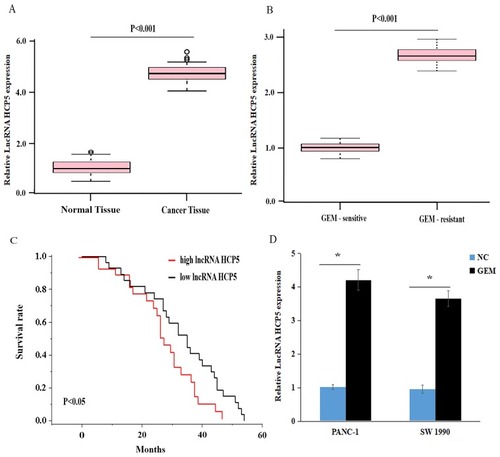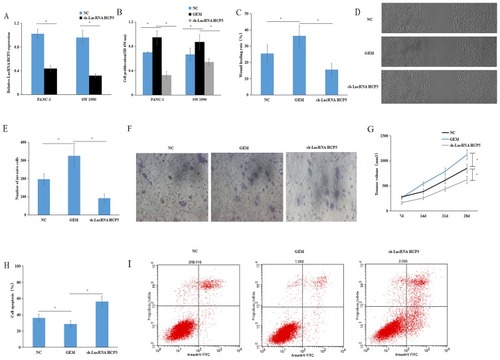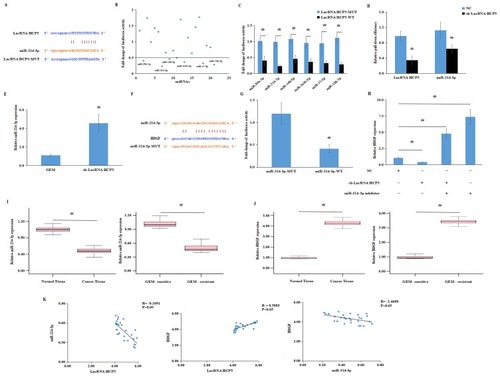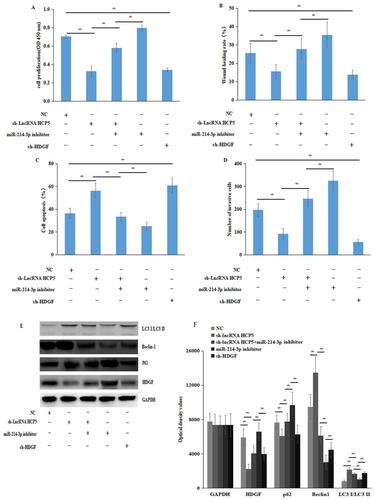Figures & data
Figure 1 lncRNA HCP5 is upregulated in patients and cell lines with PC gemcitabine (GEM) resistance. (A) qRT-PCR analysis of expression levels of lncRNA HCP5 in PC tissues compared with normal tissues. (B) The expression levels of lncRNA HCP5 in PC tissues with GEM-sensitive cells compared with GEM-resistant cell. (C) The survival rate was evaluated by Kaplan–Meier curve between high and low lncRNA HCP5 expression groups. (D) qRT-PCR analysis of expression levels of lncRNA HCP5 in PANC-1-GR and SW 1990-GR compared with their parental cell lines. Data represent mean ± SD. *P < 0.05.

Figure 2 Low-expression lncRNA HCP5 regulates PC cells’ proliferation, invasion, migration, cell apoptosis and autophagy. (A) RT-PCR assay showed sh-lncRNA HCP5 efficiently suppressed the endogenous expression of lncRNA HCP5 in PANC-1-GR and SW 1990-GR cells. (B) CCK8 assay showed that negative control or lncRNA HCP5 knockdown could significantly inhibit PANC-1-GR and SW 1990-GR cells’ proliferation. (C–F) Wound healing, transwell assays showed that negative control or lncRNA HCP5 knockdown could significantly inhibit PANC-1-GR cells’ invasion and migration. (G) Transfected PANC-1/GEM cells with negative control or with lncRNA HCP5 knockdown were injected into BALB/c nude mice and analysis of tumour volume of mice measured every week. (H, I) Flow cytometry showed that negative control or lncRNA HCP5 knockdown could significantly inhibit PANC-1-GR cells’ apoptosis. Data represent mean ± SD. *P < 0.05.

Figure 3 lncRNA HCP5 serves as a sponge for miR-214-3p to target HDGF in PC cells. (A) bioinformatic analysis to search for miR-214-3p interact with lncRNA HCP5-MUT or lncRNA HCP5-WT. (B) 21 miRNA mimics were co-transfected with the lncRNA HCP5 vector into PANC-1/GEM cells to identify miRNAs that were able to bind to the LncRNA HCP5 sequence. The line means miRNAs that inhibited at least half of luciferase activities. (C) RNA pulldown assay for the luciferase activity of lncRNA HCP5-MUT or lncRNA HCP5-WT in PANC-1/GEM cells co-transfected with 6 miRNA mimics. (D) RIP assay for the amount of lncRNA HCP5 and miR-214-3p in PANC-1-GR cells transfected with either sh-lncRNA HCP5 or negative control. (E) qRT-PCR analysis of expression levels of miR-214-3p in PANC-1-GR cells transfected with sh-LncRNA HCP5 was upregulated compared with parental control. (F) Bioinformatic analysis to search for HDGF interacts with miR-214-3p-MUT or miR-214-3p-WT. (G) Luciferase reporter assay for the luciferase activity of miR-214-3p-MUT or miR-214-3p-WT in PANC-1/GEM cells co-transfected with HDGF. (H) RT-PCR analysis of expression levels of HDGF in PANC-1-GR cells transfected with sh-lncRNA HCP5 or sh-lncRNA HCP5+ miR-214-3p inhibitor or miR-214-3p inhibitor or negative control. (I) The expression levels of miR-214-3p in PC tumour tissues compared with adjacent normal tissues and GEM-sensitive compared with GEM-resistant cells. (J), The expression levels of HDGF in PC tumour tissues compared with adjacent normal tissues and GEM-sensitive compared with GEM-resistant cells. (K) Pearson correlation was used for correlation analysis between lncRNA HCP5, miR-214-3p and HDGF in PC patients. Data represent mean ± SD. *P < 0.05.

Figure 4 lncRNA HCP5 regulated GEM-resistant PC cells by targeting miR-214-3p/HDGF axis. (A) CCK8 assay showed that negative control or sh-lncRNA HCP5 or sh-lncRNA HCP5+ miR-214-3p inhibitor or miR-214-3p inhibitor or sh-HDGF could regulate PANC-1-GR cells’ proliferation. (B) Wound healing assay showed that negative control or sh-lncRNA HCP5 or sh-lncRNA HCP5+ miR-214-3p inhibitor or miR-214-3p inhibitor or sh-HDGF could regulate PANC-1-GR cells’ migration (C) Transwell assay showed that negative control or sh-lncRNA HCP5 or sh-lncRNA HCP5+ miR-214-3p inhibitor or miR-214-3p inhibitor or sh-HDGF could regulate PANC-1-GR cells’ invasion. (D) Flow cytometry showed that negative control or sh-lncRNA HCP5 or sh-lncRNA HCP5+ miR-214-3p inhibitor or miR-214-3p inhibitor or sh-HDGF could regulate PANC-1-GR and SW 1990-GR cells’ apoptosis. (E, F), Western blot analysis the expression levels of HDGF, Beclin1, LC3 I/LC3 II and p62 in PANC-1-GR cells transfected with negative control or sh-lncRNA HCP5 or sh-lncRNA HCP5+ miR-214-3p inhibitor or miR-214-3p inhibitor or sh-HDGF, these effects revealed that lncRNA HCP5 contributed to PC GEM-resistance by acting as a ceRNA to regulates PC cells’ proliferation, invasive, migration, cell apoptosis by targeting HDGF by sponging miR-214-3p. Data represent mean ± SD. *P < 0.05.

